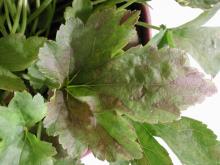Cause Aphelenchoides fragariae is a pest of various plants including anemone, African violet, begonia, chrysanthemum, coleus, ferns, geranium, hosta, iris, impatiens, lily, malva, orchids, peony, and phlox. Nematode infections are transferred to other areas and from one season to the next in planting stock or in desiccated plant parts. Foliar nematodes need a film of water to move across plant surfaces. Plant-to-plant spread in field or greenhouse occurs when plants are close together. Splashing water can move nematodes from one plant to another. Spread can be rapid even when low-volume spray stakes are used. Foliar nematodes generally are in the plant's buds and leaves but may be in the flowers, seeds and soil as well. The life cycle can be completed in 2 weeks under optimum conditions.
Symptoms Leaves may turn pale green, then yellow and later brown. The brown tissue may drop out leaving a shothole appearance. Leaf blights are often angular and bounded by larger veins. Leaf blighting may be most prevalent in mid to late summer. New growth may become curled, stunted and twisted. Secondary infections by Botrytis may also occur.
Sampling If a plant is suspected of having these nematodes, only the affected plant parts need to be submitted for diagnosis.
Cultural control
- Remove and destroy infected plants and plant debris.
- Reduce or eliminate overhead watering.
Reference Kohl, L.M. 2011. Foliar nematodes: A summary of biology and control with a compilation of host range. Online. Plant Health Progress doi:10.1094/PHP-2011-1129-01-RV.


